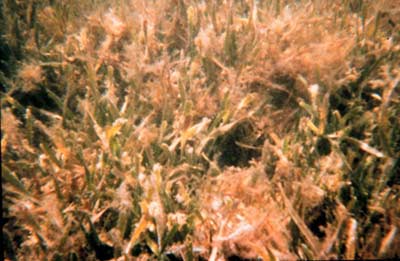TOPEX/Poseidon data has been used to study larval success rates. Spiny
lobster larvae spend much of their time in the region of the thermocline
where the current is largely geostrophically driven. Hence geostrophic
velocity vectors derived from TOPEX/Poseidon sea surface height data
provide a reasonable indication of the direction and speed that the larvae
will travel.
The study shows that altimeter derived geostrophic currents may be of use
in predicting natural repopulation success. Repopulation is a topic of
growing interest as over fishing occurs and efforts are made to replenish
stock.

The image above shows the seagrass extending offshore from mangrove shoreline. Red algae
covering seagrass is particularly important as
chemical cue for larval settlement of spiny lobster post-larvae
Photographer: Richard B. Mieremet, Senior Advisor, NOAA OSDIA
This study by Jeffrey J. Polovina, Pierre Kleiber, and Don Kobayashi
of the National Marine Fisheries Service Southwest Fisheries Science Center
- Honolulu Laboratory is in press as of April 1999. In the interim the
paper can be viewed on-line.